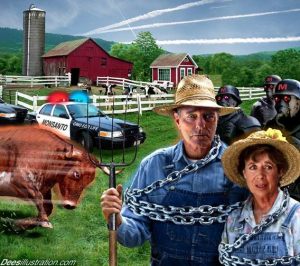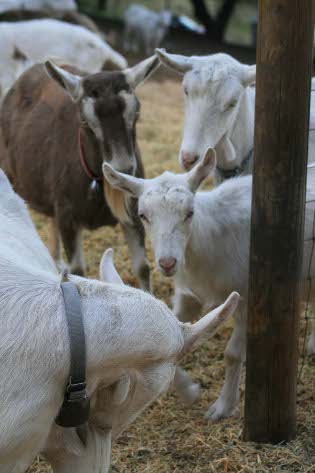from FOOD SAFETY NEWS DISCUSSION
After implementing policies for many years which complicate, if not make impossible, tracebacks to the source, USDA/FSIS seems to indicate it is willing to consider a midstream change in its attitudes, and policies, regarding Tracebacks to the TRUE ORIGIN of contamination.
The December 9 issue of Dow Jones also refers to the upcoming January USDA hearing, but no specific date has been set. One of many concerns I have is that the agency may well attempt to produce yet another prosaic Notice/Directive/Policy which multiplies words, but accomplishes nothing, the primary objective being to disingenuously and piously portray USDA as America’s ultimate public health agency. The agency’s historical refusal to traceback to the origin is readily understood.
First of all, it is pertinent to note that E.coli and Salmonella are “Enteric” bacteria, which by definition means that they emanate from within animals’ intestines, and by extension proliferate on manure-covered hides. Retail meat markets (insert Lunds/Byerlys et al), restaurants (insert Sizzlers and dozens others here), and the majority of meat processing plants (review this century’s recalls) do NOT slaughter, thus do not have animal intestines or manure-covered hides on their premises. Therefore, it is reasonable to conclude that the vast majority of E.coli and Salmonella-laced meat is caused by sloppy kill floor dressing procedures. Well, why doesn’t USDA aggressively trace back to the slaughter plant origins? If tracebacks were successfully accomplished which reveal that the contamination ORIGINATED at a slaughter plant, a public backlash would discredit both the agency and the slaughter establishments. Why? Because successful tracebacks would reveal (1) that the big slaughter plants continue to ship tonnages of contaminated meat into commerce, bearing the official USDA Mark of Inspection; and (2) the tracebacks would reveal that the agency is asleep at the wheel at the biggest plants, by official agency design. Why do I state that? Because the current form of meat inspection, which is called Hazard Analysis Critical Control Point (or HACCP) deregulated the largest slaughter facilities. Prior to HACCP, the agency promised the industry that under the HACCP protocol, (1) the agency would maintain a “Hands Off” non-involvement role, (2) the agency would no longer police the industry, but the industry would police itself, (3) the agency would disband its previous command & control authority, and (4) each plant would write its own HACCP Plan, and the agency could not tell the industry what must be in their HACCP Plans. True to its word, USDA has fully lived up to its pre-HACCP promises, but only at the deregulated largest plants. In stark contrast, the agency has used HACCP to hyper-regulate the small plants. These differences are begging for a movie or book to expose the agency’s true intentions, which are focused on justifying USDA’s semi-retirement at the biggest plants, while hagriding small plants out of existence.
Today, 88% of feedlot-fattened steers and heifers are killed at the Big 4 packer plants, which enjoy political clout and the economic wherewithal to force USDA into paralysis. The agency lives in fear, knowing that if it attempts truly meaningful enforcement actions at the big packers, the agency will be defending itself in court, and for good reason! Realizing that USDA promised to maintain a “Hands Off” non-involvement role under HACCP, that it would no longer police the industry, and would jettison its previous command-and-control authority, the agency has knowingly painted itself into a corner which prevents it from forcing changes onto non-compliant big plants. USDA fully deserves to lose such litigation, and will, so chooses to avoid litigation. So, to circumvent this delicate problem, the agency has implemented policies (some of which are not written) which prevent tracebacks to the origin.
We should not be surprised when we continually experience these ongoing outbreaks and recurring recalls, because both (1)USDA and (2)litigation have focused its sanctions against the downstream destination facilities (restaurants, retail meat markets, and further processing plants) which have unwittingly purchased meat which was previously contaminated with invisible pathogens. Until USDA is willing to Force the Source, rather than Destroying the Destination, America is virtually guaranteed ongoing outbreaks.
USDA is totally opposed to putting Bill Marler out of business, and in fact is Mr. Marler’s ultimate ally by promoting the rights of the big slaughter plants to continue producing enteric bacteria-laced meat with virtual impunity. Why does USDA appear to have experienced a sudden change in heart regarding Tracebacks? I propose that since successful tracebacks have been accomplished for melamine-laced products, spinach to a mere handful of California farms, as well as tracebacks of lettuce, peppers, peanut butter, etc, USDA’s historical inability to traceback to the slaughter plants of origin has become monumentally conspicuous in comparison. And think of the irony of this historical fact!
Although FDA has inspectors in produce plants only once every few years, the agency has successfully accomplished these tracebacks. USDA on the other hand, has inspectors in every meat plant every day, yet is strangely unable to match FDA’s success in performing tracebacks. Perhaps the Obama administration is to be credited with the USDA’s born-again metamorphosis in its alleged desire to suddenly perform tracebacks to the origin of contamination. I can guarantee everyone one thing: we had best be closely watching every statement USDA makes in its January hearing, because the agency’s past performance in this area proves that USDA fears big packer clout more than it fears public health outbreaks.
John Munsell

 As you may know the US government is trying to pass a law, HR2749, which is about imposing totalitarian control on the food supply (such as mandating GMO-food) and restricting anything natural or healthy, such as access to supplements or even any natural food. Our health and very lives and the lives of our children depend on this being stopped. This is not an exaggeration. Our food supply will be placed in the hands of large factory farms and conglomerates like Monsanto who’s only objective is profits.
As you may know the US government is trying to pass a law, HR2749, which is about imposing totalitarian control on the food supply (such as mandating GMO-food) and restricting anything natural or healthy, such as access to supplements or even any natural food. Our health and very lives and the lives of our children depend on this being stopped. This is not an exaggeration. Our food supply will be placed in the hands of large factory farms and conglomerates like Monsanto who’s only objective is profits.




 Mr. Hentges is a 1992 graduate of the University of Texas with a juris doctorate from the School of Law and a Master of Public Affairs from the Lyndon B. Johnson School of Public Affairs. He is a 1987 graduate of Oklahoma State University with a bachelor of science in agricultural economics.
Mr. Hentges is a 1992 graduate of the University of Texas with a juris doctorate from the School of Law and a Master of Public Affairs from the Lyndon B. Johnson School of Public Affairs. He is a 1987 graduate of Oklahoma State University with a bachelor of science in agricultural economics. A new food safety bill is on the fast track in Congress-HR 2749, the Food Safety Enhancement Act of 2009. The bill needs to be stopped.
A new food safety bill is on the fast track in Congress-HR 2749, the Food Safety Enhancement Act of 2009. The bill needs to be stopped.